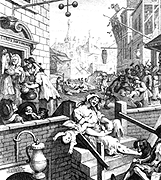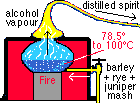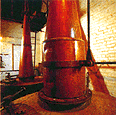Gin

|
17th century
medicine Monopolies, royal
privilege, and smuggling Smuggling to
England Napoleonic
Wars Supplying the English
smugglers |
 "Gin Lane" in London - Hogarth's print (1751) showing the social effects of heavy drinking of cheap gin amongst ordinary people in Britain in mid-18th century, after it was introduced by English soldiers. The British government put a tax on gin as a response - and also to raise money for fighting wars in the North American and Indian colonies.
|
|
After the Napoleonic
Wars Cross-channel smuggling continued in peacetime, because British import taxes remained high, and for many unemployed soldiers and sailors returned from the wars to Kent and Sussex, smuggling was the only way to make a decent living. More distilleries opened in northern France, including Wambrechies Distillery near Lille in 1817, which still has its original machinery working today. They were usually near canals, for cheap transport by barge of all the grain they needed. |
 The herby-mash liquid - a mixture of crushed rye and barley grain and juniper berries - is piped into the still and heated. Alcohol boils at a lower temperature (78.5 deg.C) than water (100 deg.C) With carefully controlled heating, the steamy vapour rising up the neck is concentrated alcohol. The distilled spirit is led off down a pipe to the right, where it cools, condenses as gin liquor and is stored in oak casks. The process was originally invented to concentrate wine for export, to save shipping space - with the intention of watering it down again at the other end. |
|
|
Miners'
drink ...now a regional
tradition |
 In the bad old days of the 19th century, coal miners' wagers were paid in the local estaminet - often owned by the mining company. |
|
|
Places
to visit: |
|
Related background
information |
|
|
|
|
|

